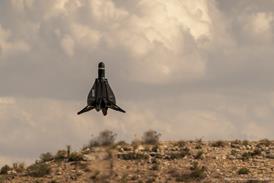The arrival of the Airbus A380 has heralded new levels of cabin comfort for both premium and economy passengers, as launch customers opt to use the giant's volume to introduce innovations and increase personal space.
While the seat counts for many of the early operators have been known for some time, the full detail of cabin layouts and innovations have only been made public for three airlines - launch operator Singapore Airlines, latest customer Emirates, and the other 2008 debutant, Qantas. All three carriers have opted for layouts with fewer than 500 seats - the latter going with an ultra-spacious 450-seat configuration - but each has taken a different approach to how and where it seats its passengers across the two decks.
The A380 is in effect two widebody airliners flying one above the other, connected by a wide straight-though stairwell at the front and a spiral staircase aft. According to Airbus, the A380 has 50% more floor space than the standard-setting Boeing 747, but only 35% more seats resulting in an increase in space for each passenger.
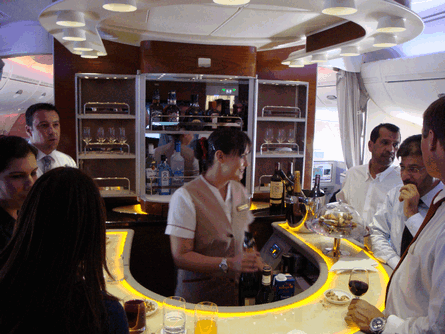 |
|---|
© Max Kingsley-Jones/Flight International |
The main deck - with a cross-section at arm rest level of 6.48m (21.3ft) - is easily the widest airliner cabin ever flown, with Airbus claiming a 36cm advantage (at arm-rests) over the 747's benchmark. This is the default location for the economy seats - all three airlines have some or all of their economy cabins there.
MAIN DECK ECONOMY
The A380's standard main deck economy layout is 10-abreast (three-four-three) with a 47cm-wide seat that Airbus says is more than 3cm wider than that offered on the 747 in a similar configuration. With narrower seats, an 11-abreast layout is feasible.
The upper deck has twin-aisle width, meaning that it lacks the cosiness of the top deck of a 747 behind the cockpit. With a width (at arm-rests) of 5.87m, it is similar in cross-section to that of the A330/A340 - although with a more pronounced upper curvature. The deck is the natural location for business class - while some economy/premium economy seats can also be found there - but only Emirates has so far put first class on the upper deck.
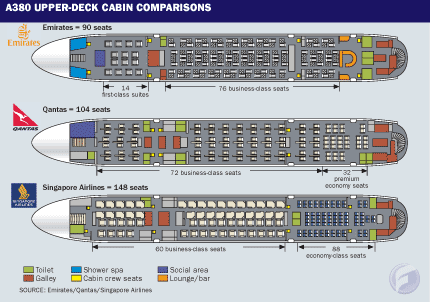 |
|---|
LARGEST CUSTOMER
The Dubai carrier, which is the largest A380 customer with 58 on order, inaugurated A380 revenue services on 1 August between Dubai and New York. It has three configurations for its fleet, with initial aircraft being delivered in a 489-seat layout, while later aircraft will have either 517 or 604 seats.
"I think when passengers get on board - premium and economy - they'll have a great experience. It's light, it's spacious, and it's airy - even in economy," says the airline's president Tim Clark.
Unlike SIA and Qantas, Emirates has chosen to make the upper deck entirely premium as part of the airline's philosophy to segregate first- and business-class passengers from economy immediately they set foot in its Dubai airport hub. "When our new terminal is open in Dubai, the boarding for the premium passengers will be straight in to the upper deck," says Clark.
The result is that Emirates has the lowest upper-deck seat count at 90 - 14 first-class suites and 76 business class.
The airline has adopted the area either side of the forward stairwell for a world first on an airliner - a pair of on-board showers for first-class passengers.
While the plumbing for the showers was "a masterpiece of engineering", Clark says the innovation's real challenge will be managing the allocation of "25min slots" for use of the facilities to first-class passengers.
"Managing that is probably going to be the most complex aspect, because we think they're going to be very popular," he says.
"The shower operates for 5min. There is an indicator light by your head that moves from green to amber to red to show how long you've got left."
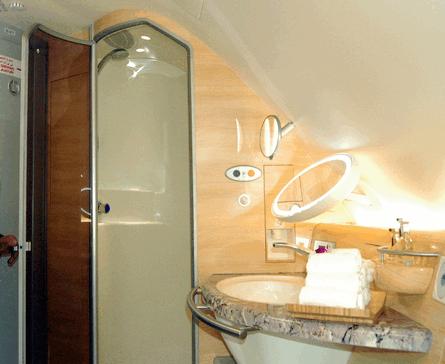 |
|---|
© Andrew Rogers/Flightglobal.com |
SIA, which operated the world's first A380 revenue service in October last year, now has five of the 471-seaters in operation, serving London, Sydney and Tokyo from its Singapore base. A further 14 are on order.
SIA's A380s have a three-class layout, but the airline is quick to point out that they do not have a first-class offering: "We don't have first class on the A380," says SIA. "Our premium cabin is the 'Singapore Airlines Suites', and we are not positioning it as first class."
SIA says it has located the 12 suites on the main deck rather than the upper "because the [greater] space available suits them well. The suites are wider and larger than those of our competitor, and fit the widest cabin space available, which is on the main deck, not the upper deck."
Qantas will introduce its first of 20 450-seat A380s into service on 20 October between Melbourne and Los Angeles, following delivery later this month. Sydney-Los Angeles services will begin on 24 October, while Singapore and London are due to come on line by early next year.
The aircraft have a four-class configuration: 14 first, 72 business, 32 premium economy and 332 economy. The Australian flag carrier's executive general manager John Borghetti says that its A380 interior, designed exclusively for Qantas by Australian industrial designer Marc Newson, would set a new benchmark for the airline: "Qantas has combined intelligent design with functionality to deliver more space and comfort in every cabin."
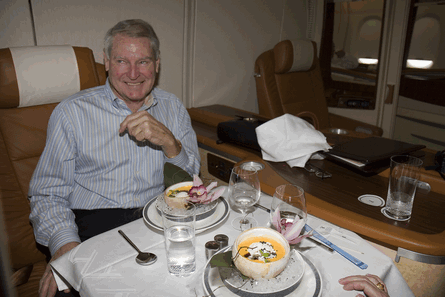 |
|---|
Following the example of SIA, Qantas opted to make use of the wider girth offered on the main deck for its first-class cabin, which comprises 14 "private suites" three abreast incorporating a seat manufactured by B/E Aerospace's VIP jet group "that swivels into an armchair and a fully flat, extra long and very wide bed", says Borghetti.
On the upper deck of the Emirates A380s behind the first-class cabin are 76 business-class seats arranged in a four-abreast (one-two-one) layout, with each one including its own "mini-bar". Emirates describes the layout as an example of "intelligent seating", because all the seats have direct aisle access.
The middle seats alternate between being side-by-side with the mini-bars outboard, or apart with the mini-bars between them.
MINI-BAR
Similarly, some window seats have their mini-bar on the outer (aisle) side, while others are between the seat and the cabin wall. As such the A-E-F-K seat positions in one row alternate with the B-D-G-J positions in the next.
The configuration means about half the business seats have a reduced personal space compared with the other half, but Emirates does not intend to offer a fare differential. Because the A-E-F-K row consists of window and central positions, requiring access from the aisle, the site for the on-aisle B-D-G-J seats is around 20cm shorter than that for their counterparts.
This reduces the overall length of the fully reclined bed and brings the in-flight entertainment screen closer to the passenger by the same distance. Emirates service-delivery chief Terry Daly says that the carrier does not believe this will be an issue with passengers, however, adding: "We won't be differentiating [the fares]."
Located on the upper deck between the rear of the business-class cabin and the aft galley is a bar area for Emirates premium passengers. The lounge incorporates two settees as well as a large flat-screen display showing live video from the camera mounted high in the A380's tailfin. One A380 passenger describes it as having the feel of the "observation lounge" found on cruise liners - unsurprising as the bar was the brainchild of Clark, who is fond of all things maritime.
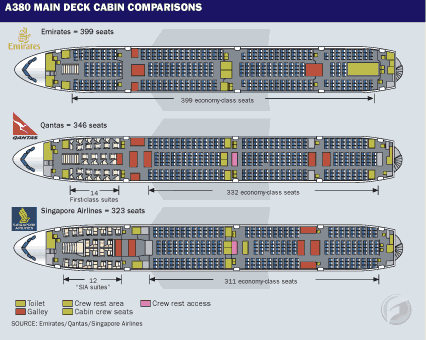 |
|---|
SIA and Qantas have their business class cabins upstairs, along with some economy and/or premium economy seating. SIA's upper deck has 148 seats - 60 business and 88 economy. "The upper deck is very well-suited to positioning of the business class cabin, with its one-two-one fully forward facing configuration," says the airline.
Qantas's upper deck has 104 seats - 72 business-class seats in three cabins, and 32 premium economy at the rear. The business-class seats are configured in a six-abreast two-two-two layout and Qantas says they are enhanced versions of the existing "Skybed sleeper seat offering a longer, fully flat bed with enhanced cushioning, a larger in-arm entertainment screen and additional storage options".
PRIVATE LOUNGE
Borghetti describes the private lounge area on the upper deck of the aircraft as "a key feature of Qantas A380's Business cabin". Located in the vestibule the right of the forward stairwell, this lounge features leather sofas, a self-service bar offering snacks and drinks, large video monitor with laptop connectivity and a feature display cabinet.
The aft part of the Qantas A380 upper deck is given over to the airline's new premium economy cabin offering "more space, comfort and an enhanced level of service". Seats are configured in a seven-abreast, two-three-two layout and passengers have access to a self-service bar offering snacks and soft drinks in addition to the regular meal service.
The downstairs on Emirates A380s is an all-economy affair, with 399 seats arranged in four cabins - the majority of the seats in the typical A380 main deck are 10-abreast in a three-four-three layout. Clark describes the cabin as "very special" and points out that the width would have allowed the airline to stack the seats in 11 abreast layout. "There's plenty of room for people to move around," he says. "The door-entry areas are very spacious as they don't have any seats around them. You'll get a high degree of mobility in flight."
Emirates is to test a lighter seat foam for economy as part of a weight-reduction study, which could save up to 500kg (1,100lb) on the A380. The trial will include pressure tests to gauge the density of the foam, how much it decompresses and how it regains its firmness.
SIA says that its A380 economy seating has been slotted in where the "space remains on the upper deck" behind business, while the bulk of the seats are located aft of the suites on the main deck.
Qantas's main deck contains 332 economy seats in three cabins behind first class, with four self-service bars similar to that in premium economy upstairs.
Qantas and SIA have adopted the standard A380 crew rest location plan, with the two flightcrew compartments located behind the cockpit and the 12-berth cabin crew module below deck in the forward part of the rear cargo hold where it occupies the space of two pallets. Airbus also offers a 12-berth upper-deck cabin crew rest module that slots in at the back of the cabin behind doors three.
CREW REST
Only Emirates' "long-range" configured 489-seat A380s have a crew rest zone, which is at the rear of the main deck in the centre of aft economy cabin. The space freed at the front of the main deck by the elimination of the flightcrew rest zone has been used for three lavatories. Clark says the decision to put the cabin-crew rest on the main deck was basically to preserve cargo capacity. "There is not much volume on the bottom deck," he says, adding that cargo can account for up to 20% of the airline's overall income.
The airline is due to take its first "medium-range" configured A380s next year that will differ mainly in that the crew rest zone will be removed and replaced with 28 economy seats, says Clark. These will be used on sectors of less than 12h.
From 2010, Emirates will introduce A380s with a two-class cabin layout seating 604 passengers - 60 business and 544 economy. These will be used on "regional" routes of up to 6h from Dubai.
 |
|---|
Meanwhile, SIA says it has not ruled out changing its A380 seating on later deliveries: "The configurations for our A380s are determined for the first order of 10. The layout for the next order of nine can be settled later, and we'll use the early feedback and market data from operating the routes we're now flying to determine whether we want to make adjustments or changes."
By year-end, passengers will be able tocircle the globe in a multitude of ways aboard the world's largest airliner. While the cabins may lack the on-board bedrooms and duty-free shops once promised by the marketeers, the launch carriers have incorporated some clever innovations to make flying by A380 a memorable experience.
Have you flown onboard an A380? Tell us about your experience
Source: Flight International




